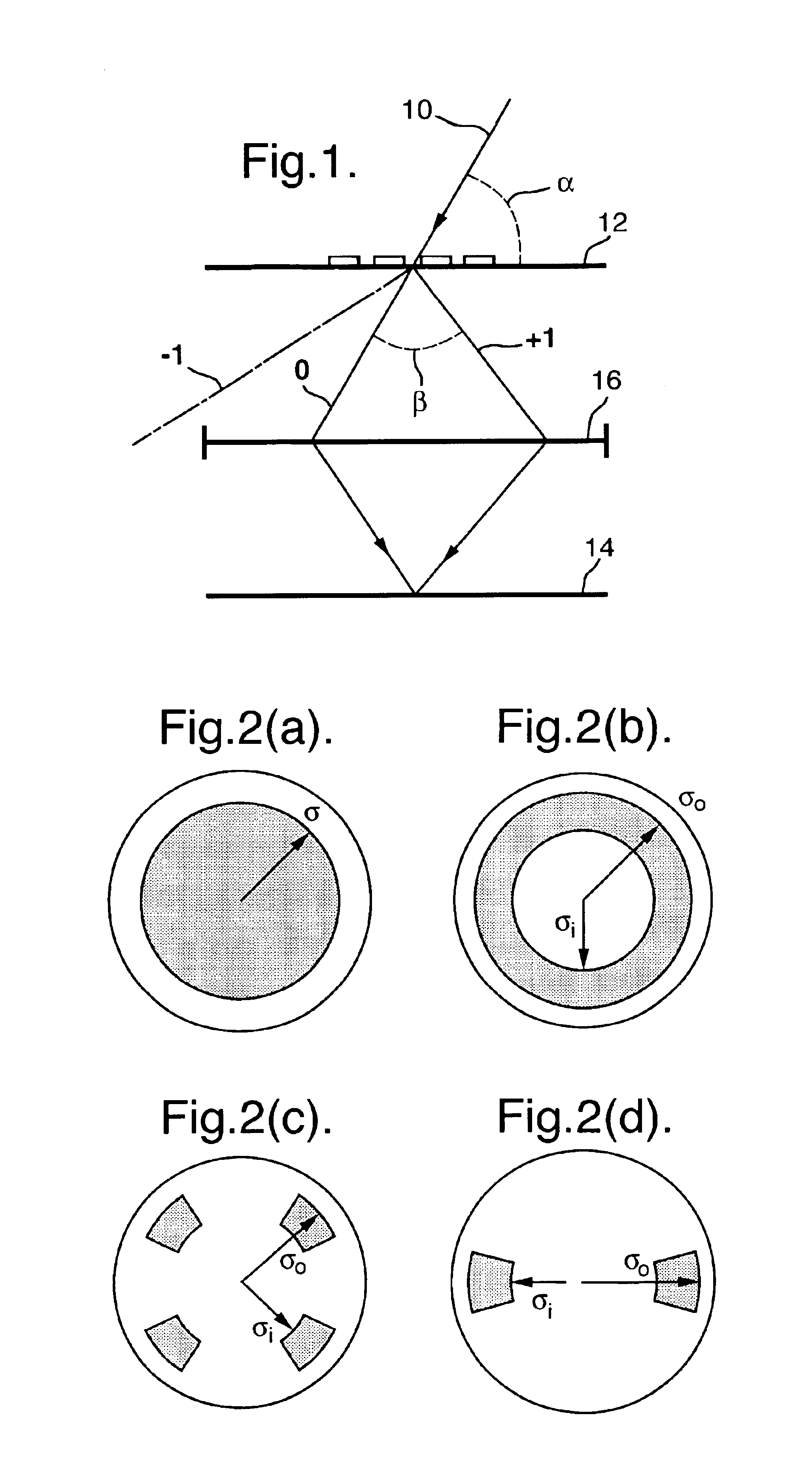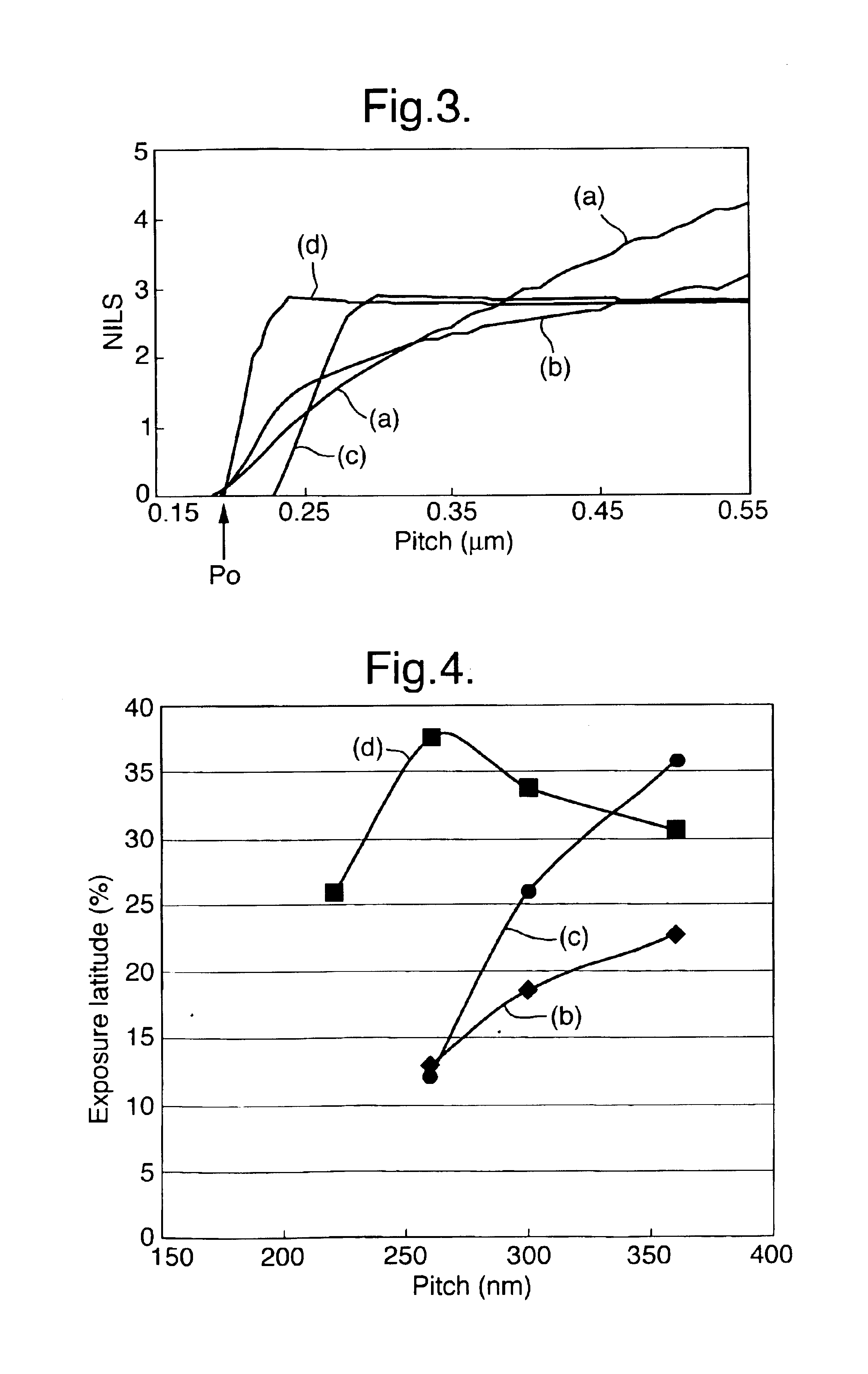Lithographic method and apparatus
a technology of lithographic exposure and lithographic method, which is applied in the direction of printers, photo-taking processes, photographic processes, etc., can solve the problems of increasing the density of features, increasing the demand for ever-smaller features, and proving expensive, so as to reduce the size of features
- Summary
- Abstract
- Description
- Claims
- Application Information
AI Technical Summary
Benefits of technology
Problems solved by technology
Method used
Image
Examples
embodiment 1
In optical lithography it is known to use off-axis illumination, which enables smaller features to be successfully imaged. With this technique, the mask is illuminated at non-perpendicular angles, which in particular improves the process latitude by increasing the depth of focus and / or contrast.
FIG. 1 illustrates this principle in which a beam of radiation 10 is incident on a mask 12 at an angle 90°-α inclined to the optical axis, which is conventionally vertical. The incident beam 10 is diffracted by the features on the mask 12 which are to be imaged on the wafer 14. The zeroth and two first-order-diffracted beams (0, ±1) are shown in FIG. 1. Improved performance can be achieved when, for example, at least part of the zeroth order and one of the first orders, which are coherent, are captured by the projection lens 16 and used to form the image on the wafer 14.
The smaller the pitch of features on the mask 12 the larger the diffraction angle β will be. If the size of the features dec...
embodiment 2
A preferred embodiment of the method of the invention is to perform two exposures using two respective perpendicular dipole patterns. The first exposure is used to image mask features parallel to a first direction, and the second exposure using the other dipole illumination mode is used to image mask features perpendicular to the first direction.
In one particular embodiment, two distinct masks are used, one for each of the exposures, and the superposition of the images of the two masks produces a single circuit pattern. As well as changing between mutually perpendicular dipolar illumination modes and changing masks between the first and second exposures it is possible to select independently the specific parameters of the dipole illumination mode for each exposure, such as σo and σi and so on, in order to optimize the exposure for the structure sizes parallel and perpendicular to the first direction.
In an alternative embodiment, a single mask is used, but the said mask contains two ...
embodiment 3
A further embodiment of the present invention is to use a “soft dipole” illumination mode for at least one of the dipole exposures. A soft dipole mode is particularly suited to imaging a pattern which includes some features which are not in the x or y directions; for example, diagonal or curved lines. Some examples of soft dipole illumination modes include a basic dipole intensity distribution as shown in FIG. 2(d) but with a weaker general background illumination across the pupil, or with a weaker central on-axis pole in addition to the two off-axis poles, or it may resemble a quadrupole illumination mode, but with two strong intensity poles and two weaker intensity poles.
PUM
| Property | Measurement | Unit |
|---|---|---|
| energy-sensitive | aaaaa | aaaaa |
| size | aaaaa | aaaaa |
| electric field | aaaaa | aaaaa |
Abstract
Description
Claims
Application Information
 Login to View More
Login to View More - R&D
- Intellectual Property
- Life Sciences
- Materials
- Tech Scout
- Unparalleled Data Quality
- Higher Quality Content
- 60% Fewer Hallucinations
Browse by: Latest US Patents, China's latest patents, Technical Efficacy Thesaurus, Application Domain, Technology Topic, Popular Technical Reports.
© 2025 PatSnap. All rights reserved.Legal|Privacy policy|Modern Slavery Act Transparency Statement|Sitemap|About US| Contact US: help@patsnap.com



